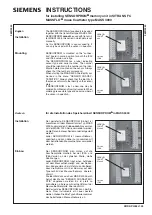
Rev. 1.50
1�6
����st ��� �01�
Rev. 1.50
1��
����st ��� �01�
HT66F0175/HT66F0185
A/D Flash MCU with EEPROM
HT66F0175/HT66F0185
A/D Flash MCU with EEPROM
�DCEN
ST�RT
�DBZ
S�CS[�:0]
off
on
off
on
t
ON�ST
t
�DS
�/D samplin� time
t
�DS
�/D samplin� time
Start of �/D conversion
Start of �/D conversion
Start of �/D conversion
End of �/D
conversion
End of �/D
conversion
t
�DC
�/D conversion time
t
�DC
�/D conversion time
t
�DC
�/D conversion time
011B
010B
000B
001B
�/D channel
switch
(S�INS =000B)
A/D Conversion Timing
Summary of A/D Conversion Steps
The following summarises the individual steps that should be executed in order to implement an A/D
conversion process.
Step 1
Select the required A/D conversion clock by properly programming the SACKS2~SACKS0 bits in
the SADC1 register.
Step 2
Enable the A/D converter by setting the ADCEN bit in the SADC0 register to 1.
Step 3
Select which signal is to be connected to the internal A/D converter by correctly configuring the
SAINS2~SAINS0 bits
Select the external channel input to be converted, go to Step 4.
Select the internal analog signal to be converted, go to Step 5.
Step 4
If the A/D input signal comes from the external channel input selecting by configuring the SAINS
bit field, the corresponding pins should first be configured as A/D input function by configuring the
relevant pin-shared function control bits. The desired analog channel then should be selected by
configuring the SACS bit field. After this step, go to Step 6.
Step 5
If the A/D input signal is selected to come from the internal analog signal, the SAINS bit field
should be properly configured and then the external channel input will automatically be disconnected
regardless of the SACS bit field value. After this step, go to Step 6.
Step 6
Select the reference voltgage source by configuring the SAVRS3~SAVRS0 bits.
Step 7
Select the A/D converter output data format by configuring the ADRFS bit.
















































